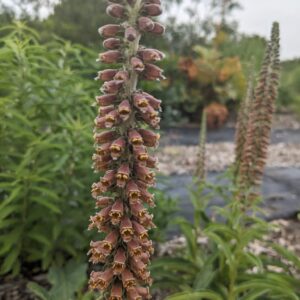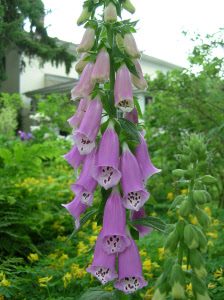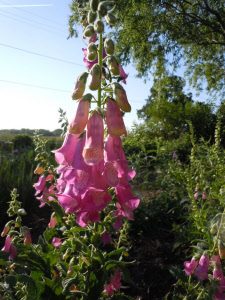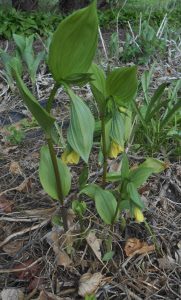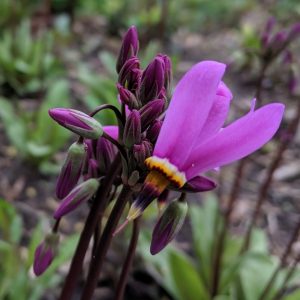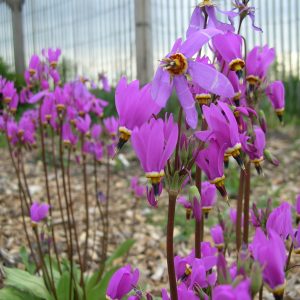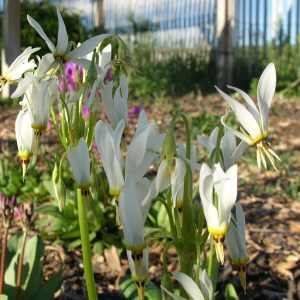Our Plants
Showing 185–192 of 587 results
-
Digitalis lutea Straw foxglove, Small yellow foxglove Z 3-9
Mid-summer, honey yellow, small bells encircle the flower spike
Mid-summer, honey yellow, small bells encircle the flower spike.
Size: 24" x 12"
Care: Sun to part shade in moist well-drained soil.
Native: Central Europe south to NW AfricaThe word ‘fox’ is often said to be a corruption of ‘folk,’ meaning the ‘little folk’ or fairies.” Foxgloves reputedly had the power to ward off witches and return children kidnapped by fairies. This species identified by Bavarian physician Leonhart Fuchs (1501-1566) in 1542. D. lutea mentioned in Gerard’s Herball in 1632.
-
Digitalis parviflora Chocolate foxglove Z 3-9
Spikes densely encircled with small, red-brown bells for weeks in summer, prune back after flowering to encourage reflowering.
OUT OF STOCK
Spikes densely encircled with small, red-brown bells for weeks in summer, prune back after flowering to encourage reflowering.
Size: 24- 60” x 12”
Care: sun to part shade in moist well-drained to well-drained soil
Native: Picos de Europa Mountains of Northern Spain
Wildlife Value: attracts bees and butterflies for its pollen and nectar, deer and rabbit resistant.
Awards: Royal Horticultural Society Award of Garden MeritGrown by Tradescant the Elder, 1634.
-
Digitalis purpurea Foxglove Biennial (year 1 rosette of leaves, year 2 flowers then dies) Z 4-8
Early summer pink or purple spire of spotted bells.
OUT OF STOCK
Early summer pink or purple spires of spotted bells.
Size: 3-5' x 24"
Care: Part shade moist well-drained soil. Deer resistant
Native: Great Britain,west and central Europe east to Scandinavia, often escapes.Druids were fond of this because it flowered at the same time as their midsummer sacrifice. First identified in writing by German physician and botanical author Leonhard Fuchs (1501-1566). Grown in the Eichstätt Garden, the garden of Johann Konrad von Gemmingen, prince bishop of Eichstätt in Bavaria, c. 1600. “Foxglove boiled in water or wine, and drunken, doth cut and consume the thick toughnesse of grosse and slimie flegme and naughty humours; it openeth also the stopping of the liver, spleene, and milt, and of other inward parts.” Gerard’s Herball, 1596.
The plant’s use as a heart stimulant was discovered in 1775 by English physician William Withering. Liberty Hyde Bailey called foxgloves: “old-fashioned and dignified… The word ‘fox’ is often said to be a corruption of ‘folk,’ meaning the ‘little folk’ or fairies.” These reputedly had the power to ward off witches and return children kidnapped by fairies. The first documented reference of American cultivation was in 1748 by Peter Kalm, a student of Linnaeus and a Swedish botanist. English merchant Peter Collinson sent a white one to John Bartram in 1735. George Washington received a gift of one to cure Dropsy.
-
Digitalis thapsi Spanish foxglove Z 5-9
Spikes of purple, rose-spotted trumpets in early summer. True perennial. Although this is not as big as Digitalis purpurea, this is a perennial that grows for years.
Spikes of purple, rose-spotted trumpets in early summer. True perennial. Although this is not as big as Digitalis purpurea, this is a perennial that grows for years.
Size: 18” x 12”
Care: sun to part shade in moist well-drained soil.
Native: Spain & PortugalGrown in the botanical gardens of Moscow by 1752. Philip Miller (1691-1771), chief gardener at London’s Chelsea Physic Garden, received seeds from Spain and grew this by 1760’s
-
Disporum flavens Fairy bells Z 4-9
Upright stems, arch on top where moon-yellow bells dangle, elegant counterpoint to spring perennials
Moon-yellow bells dangle at the top of tall, upright stems. Elegant counterpoint to spring perennials
Size: 25-30” x 16-20”
Care: shade to part shade in moist-well-drained soil
Native: KoreaCollected in 1926 in Manchuria and described in Botanical Magazine (Tokyo) in 1934.
-
Dodecatheon jefferyi syn. Primula jefferyi Sierra shooting star, Tall mountain shooting star Z 5-8 Ephemeral
Fuschia, reflexed petals, looking like a descending shuttlecock or, as named, a shooting star, dangle from stems in late spring to early summer
OUT OF STOCK
Fuschia, reflexed petals, looking like a descending shuttlecock or, as named, a shooting star, dangle from stems in late spring to early summer
Size: 18-24” x 14-18”
Care: sun to part shade in moist to moist well-drained soil
Native: Pacific NW Alaska- CA & east in Montana and IdahoFirst collected by Meriwether Lewis on the Expedition at the Dalles of the Columbia River on April 16, 1806. Named for Scottish botanist John Jeffrey, who collected it and explored the Okanagan and Fraser regions with the Hudson Bay Co. in 1851-53.
-
Dodecatheon meadia syn. Primula meadia Pink Shooting Star Z 4-8 Ephemeral
Rosy-lilac reflexed flowers, looking like a descending shuttlecock, dangle from stems in spring
Only available for purchase in spring – Ephemeral
Rosy-lilac reflexed flowers, looking like a descending shuttlecock, dangle from stems in spring
LIMITED QUANTITIES AVAILABLE. LIMIT OF 1 PER CUSTOMER PLEASE.
Size: 12-24” x 6-12”
Care: sun to part shade in moist well-drained soil.
Native: PA to Wisconsin, south to TX.
Awards: Royal Horticultural Society Award of MeritName Dodecatheon from the Greek dodeka (twelve) and theos (gods), meaning 12 superior gods, after the name given to another plant by Roman author, Pliny the Elder. The species name meadia after Richard Mead, physician to George III. John Tradescant the Younger sent this to England by 1640. “A favorite among old border flowers.” William Robinson, 1899.
-
Dodecatheon meadia syn. Primula meadia Shooting Star Z 4-8 Ephemeral
White reflexed flowers, looking like a descending shuttlecock, dangle from stems in spring. Ephemeral. Let it drop its seed and in three years you will have more. There are pink ones but not as vigorous, rare.
Available to order in Spring only
White reflexed flowers, looking like a descending shuttlecock, dangle from stems in spring. Ephemeral. Let it drop its seed and in three years you will have more. There are pink ones but not as vigorous, rare.
Size: 12” x 6”
Care: sun to part shade in moist well-drained soil
Native: PA to Wisconsin, south to TX.
Awards: Royal Horticultural Society Award of Merit.Dodecatheon from the Greek dodeka (twelve) and theos (gods), meaning 12 superior gods, after the name given to another plant by Roman author, Pliny the Elder. The species name meadia after Richard Mead, physician to English King George III. John Tradescant the Younger sent this to England by 1640. “A favorite among old border flowers.” William Robinson, 1899. This showy native can be found in open woodland, prairies, meadows, and on rocky slopes in the eastern United States. Introduced into European gardens as early as 1704, Philadelphia nurseryman and explorer John Bartram described this species of Dodecatheon in 1783. The white version was offered, along with several in shades of purple, by Long Island’s Prince Nursery in 1857.


